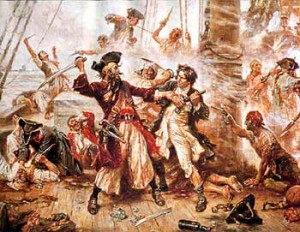 Rediker, Marcus. 2004. Villains of All Nations: Atlantic Pirates in the Golden Age. Boston: Beacon Press.
Rediker, Marcus. 2004. Villains of All Nations: Atlantic Pirates in the Golden Age. Boston: Beacon Press.
The dialectics of violence on the eighteenth century Atlantic were spurred by three sources of terror: pirates, violent state repression against piracy, and the oppressive prison-like conditions of merchant ships. Piracy was as much a parasite of a burgeoning maritime capitalism, as it was a direct response to the oppressive conditions experienced by the sailors of merchant ships—those machines of that era’s globalism. Marcus Rediker’s Villains of All Nations shows how the pirate ship became a world turned upside down that “limited the authority of the captain, resisted many of the practices of capitalist merchant shipping industry, and maintained a multicultural, multiracial, and multinational social order” (17). Meanwhile, pirates turned terror against terror (13). The hoisting of the Jolly Roger was often enough to induce the surrender of merchant ships.
Pirate society was wedded by a “legal philosophy that was not… an imitation of ‘the legal government’ but rather a critique of it” (42). In many cases, the starting point of these renegade micro-societies was a mutiny, a “shipboard insurrection, a revolution in miniature” (47). Considering the dire conditions of the merchant ships, it’s not hard to understand why twentyish year-old men—which they often were—decided to go a-pirating. Piracy turned from being a state-sponsored paramilitary activity attacking the fighting-trading fleets of other nations in the sixteenth century, to an increasingly democratized adventure under the management of the proletarians of the deep at the beginning of the eighteenth.
“The transmission of pirate culture through space and time was linked closely to their success in attracting new recruits and to their democratic—one might say anarchic—form of self-organization” (79). Pirate sovereignty was multiple and interdependent: from the individual-popular sovereignty of the pirate as part of the crew and the rule of the ship, to the pirate enclaves in Honduras, Bahamas, Bermuda, and Madagascar. “Pirates perceived themselves and their social relations through a collectivist ethos that had been forged first in their struggle for survival, first as seamen, then as outlaws” (101).
Although the vast majority of pirates were men, Rediker devotes a chapter to show how women also made a space for themselves in pirate society through the story of two women: Anne Bonny and Mary Read. Even more so than their male counterparts, these women were dehumanized and criminalized as beyond the pale of proper human, moral, and religious society. The villainization of pirates in general worked through the same mechanisms: “The pirate’s enemies had slowly but thoroughly disconnected him from the social order, showing him to be the enemy of all individuals, property owners, the colony, the empire, the King, the British nation, the world of nations, and all mankind” (146).
The spatial aspects of piracy come through at various points in the book: the biophysical strategic aspects of their geographic strongholds—the shallow reef-ridden waters of the Caribbean basin—and their relatively far-off safe-havens (Bahamas, Madagascar) (29). The pirate ship’s purposeful transgression of spatialized social segregations common to merchant vessels (65). And, perhaps most powerful, the frontier-like social construction of the sea:
The pirate’s image was closely related to the space he occupied—the sea, a distant place full of dangers, a site of frequent disaster, a potential path of invasion to England and the colonies, and finally a natural space that was difficult if not impossible to control…. The pirate’s occupation of a space that was dangerous and distant from centers of authority was a vital element in his image…. The suggestion that distance from authority conferred power on the pirate illustrates a crucial point. (134-135)

Pingback: Geographies of the Outlaw | Territorial Masquerades
Pingback: Salty Geographies | Territorial Masquerades